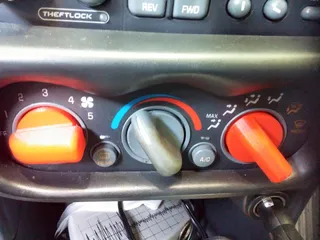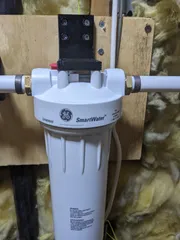Raspberry Pi 7in Touchscreen Wall Mount
Wall mount for a raspberry pi 7" touchscreen (including the pi)
35
206
1
2160
updated January 18, 2024
Description
PDFThis is a wall mount for the Raspberry Pi 7" touchscreen. I originally designed this so I could replace my old alarm system panels with a central control panel for Home Assistant. It also has a DHT22 sensor so I can monitor temp/humidity as well. The screen mount will need to have supports for the sensor standoff in the center, but the rest doesn't need any support material. I printed all of the parts in PETG, but PLA should work fine.
Features:
- Easy mounting - The wall bracket will hold the screen mount by itself with no screws, making it easier to install the screws to secure the screen mount to the bracket
- Sensor mount - Standoff for mounting various sensors (I used a DHT22)
- Support for 40mm fan - Used for cooling the Pi and for sensor airflow
Materials List:
- M3 Screws & Nuts
- 10x M3 Nuts (only 8 if not using the 40mm fan)
- 8x M3 x 14mm Hex Screws
- 2x M3 x 18mm Hex Screws (only required if using the fan)
- 5x M3 x 5mm Hex Screws (only 4x if not installing a sensor)
- Raspberry Pi (All models should work minus the Pi Zero, I used a 3 B+ since it's what I had lying around)
- Raspberry Pi 7" Touchscreen
- 40mm Fan (optional, but recommended for Pi cooling and sensor airflow)
- I used a Noctua so it would be quiet, and it has a connector that can have 2 Dupont connectors added to directly connect to the Pi GPIO, making wall installation easier.
- Pi Heat Sink Kit (optional, but recommended for Pi cooling)
- Right angle USB cable for power
- DHT22 (optional)
- 2x DuPont Connectors (only needed if using Noctua fan with connector)
Instructions:
- Wire the Raspberry Pi and mount it to the touchscreen using the parts provided in the kit (ribbon cable, wires and standoffs), and attach the Pi heat sinks if you're opting to use them.
- Take the left and right wall brackets, and install 4 M3 nuts (2 each) using the screw pull method (use a screw to pull the nut into the recessed area)
- With the touchscreen on a table and the Pi orientated with the GPIO pins on the top and the USB pointing to the right, loosely attach the left and right brackets on their respective sides with the (4) M3x5mm screws.
- Take the main housing and lay it on a table, orientating it so the standoff is at the bottom. (If you are not attaching a DHT22, you can skip this step)
- Attach the sensor side wires if they are not already and attach the DHT22 to the standoff using the last M3x5mm screw. (If you are not attaching a DHT22, you can skip this step)
- Orientate the main housing so the flat side is against the table, and the side the the recessed area for the screen to drop in is facing up. Make sure the standoff is at the bottom of the housing.
- Flip the touchscreen with the Pi attached and carefully lower it into the main housing. Be careful as some of the wires may catch on the edges. Please note: The tolerances for the recessed area are a bit tight, so a slight bit a force may be needed to get the screen to fully recess into the slot. Be careful and don't apply too much pressure as the screen might crack.
- Using 4 M3x14mm screws (2 per side), start the screws that attach the touchscreen brackets to the main housing on the left and right sides. Please note this can be a bit tricky and the brackets may need adjustment to align to the screw holes correctly.
- Once everything is aligned and all 4 screws have been started, fully tighten them down.
- If using a DHT22, finalize the wiring by connecting the other end to their respective GPIO pins.
- Take the wall plate and insert the 6 M3 nuts using the screw pull method as the L/R brackets earlier.
- Orientate the wall bracket so the 2 M3 nuts on the outside are on the top.
- Using the 2 M3x18mm screws, attach the Noctua fan to the wall bracket. Ensure the Noctua fan is orientated with the back of the fan and the wires coming out, against the inside of the bracket.
- With the black connector that has 2 wires and is included in the Noctua box, crimp a connector on each wire with DuPont connectors. Once the connectors are crimped, plug the wires into their respective 5V and Ground GPIO pins.
- Attach right angle power adapter to the Pi.
- Attach the wall bracket to the wall using at least 4 screws, orientating the bracket so the Noctua fan is on the top.
- Carefully raise the main housing with the touchscreen to the wall bracket and plugin the Noctua fan to its connector, and also plugin the other side of the right angle power cord to the power source for the Pi.
- Once all the cables are plugged in, carefully place the main housing over the bracket and ensure no wires are in the way. Please note that the wall bracket is able to hold the main housing without the screws, but be careful and don't bump it while getting the screws for final install as it may fall down. It may also be a bit tricky getting the housing on the bracket, but it completely depends on the accuracy of the printer that printed the parts.
- Once the main housing is on the wall bracket, use the last 4 M3x14mm screws to securely attach the main housing to the wall bracket. The holes should line up with little to no adjustment, so if the screws aren't going in the main housing may not be pushed all the way back.
- You're done! Enjoy your wall mounted Raspberry Pi touchscreen :)
Tags
Model origin
The author marked this model as their own original creation.




